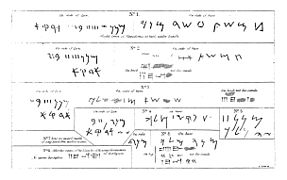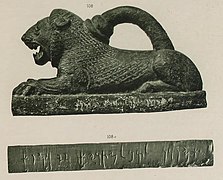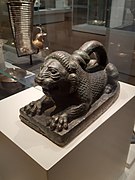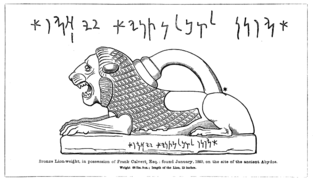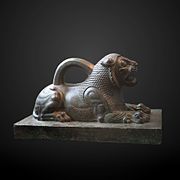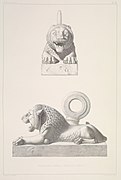أوزان الأسد الآشورية
| مادة الإنشاء | |
|---|---|
| خط الكتابة | |
| تاريخ الإنشاء |
حوالي 700 - 800 سنة قبل الميلاد |
| تاريخ الاكتشاف |
1845–1851 |
| موقع الحفظ | |
| المعرف |
ME 91220 |
أوزان الأسد الآشورية هي مجموعة تماثيل برونزية للأسود، أكتشفت خلال اعمال التنقيب الآثرية في آشور القديمة أو في المناطق المحيطة بها.
أول مجموعة منشورة والأكثر شهرة من هذه القطع الآثرية هي مجموعة من ستة عشر وزناً برونزياً من بلاد ما بين النهرين عُثر عليها في موقع النمرود الآثري في أواخر أربعينيات القرن التاسع عشر وهي الآن محفوظة في المتحف البريطاني.[1] يُعتقد أنها تعود إلى القرن الثامن قبل الميلاد، وتحمل نقوشاً ثنائية اللغة بالكتابتين المسمارية والفينيقية؛ تُصنف تلك النقوش الأخيرة ضمن مدونة النقوش السامية بالرقم "CIS II 1-14"
أوزان النمرود
[عدل]يُعود تاريخ أوزان النمرود إلى القرن الثامن قبل الميلاد، وتحمل نقوشاً ثنائية اللغة بالكتابتين المسمارية والفينيقية. وتعود النقوش الفينيقية إلى نفس الفترة التي تعود إليها نقوش "مسلة ميشع"من الناحية الكتابية.[2][3] وهي واحدة من أهم مجموعات القطع الأثرية التي تثبت الشكل "الآرامي" للكتابة الفينيقية.[4] في وقت اكتشافها، كانت أقدم نقوش على الطراز الفينيقي تم اكتشافها.[5]
أكتشف أوستن هنري لايارد الأوزان في تنقيباته الأولى في النمرود (1845-1851)، حيث عُثر على زوج من الثيران المجنحة عند بوابة، سقط أحدهما على الأخر وانكسر إلى عدة قطع. بعد رفع التمثال، اكتشف فريق أوستن لايارد تحته ستة عشر وزناً على شكل أسد.[6]قام إدوين نوريس بفك رموز هذه القطع الأثرية فيما بعد، مؤكداً أنها كانت تُستخدم في الأصل كأوزان.[7]
تشكل المجموعة سلسلة منتظمة من الأوزان تتضاءل في الحجم من 30 سم إلى 2 سم في الطول. الأوزان الأكبر حجماً لها مقابض مصبوبة على أجسامها، أما الأوزان الأصغر فلها حلقات مُثبتة عليها. وتضمنت مجموعة الأوزان أيضاً أوزاناً حجرية على شكل بط. تُمثل هذه القطع الأثرية أقدم مثال مؤكد للنظام العددي الآرامي.[8] ثمانية من أوزان الأسد هذه هي القطع الوحيدة التى تحمل نقوش تعود إلى الفترة القصيرة التي حكم فيها شلمنصر الخامس.[9] اكتشف أوزان أسد برونزية مماثلة أخرى في أبيدوس غرب تركيا (الأن في المتحف البريطاني[10]) وموقع شوشان الآثري في إيران بواسطة عالم الآثار الفرنسي جاك دي مورغان (الآن في متحف اللوفر، باريس).[11]
عُرف نظامان للأوزان والمقاييس في الشرق الأوسط القديم. اعتمد أحدهما على وزن يسمى "المينا" والذي يمكن تقسيمه إلى ستين وزناً أصغر تسمى "الشيكل". أما أوزان الأسد هذه فتُنتمي إلى نظام مختلف يعتمد على "المينا الثقيل" الذي يزن حوالي كيلوغرام واحد. وكان هذا النظام لا يزال مستخدمًا في الفترة الفارسية ويُعتقد أنه كان يستخدم لوزن المعادن.
ًصُنفت أوزان الأسد في مدونة النقوش السامية بالرقم "CIS II 1-14"، مما يجعلها أول نقش آرامي في تلك المدونة الضخمة.[12]
المعرض
[عدل]-
رسم تخطيطي لأحد أوزان الأسد عام 1864
-
لقطة مقربة
-
رسم تخطيطي للنقوش من الأسود رقم 1-8 يعود تاريخه إلى عام 1856
-
رسم تخطيطي يعود تاريخه إلى عام 1856 للنقوش من الأسود رقم 9-15 والبط رقم 1-5
-
أوزان الأسد في مدونة النقوش السامية
وزن أبيدوس
[عدل]كان الاكتشاف الثاني لوزن الأسد في أبيدوس (تركيا الحديثة)، ويرجع تاريخه إلى القرن الخامس قبل الميلاد.[13][14] وهو موجود حاليا في المتحف البريطاني، برقم القطعة E32625.
ويحتوي على نقش آرامي مُصنف باسم KAI 263 أو CIS II 108.
-
ثقل أسد آشوري آخر كبير عليه نقشآراميفي مجموعة المتحف البريطاني، من أبيدوس، تركيا، القرن الخامس قبل الميلاد
-
صورة معاصرة لوزن الأسد من أبيدوس، المتحف البريطاني
-
لقطة مقربة
-
رسم تخطيطي لفرانك كالفرت، 1860
وزن شوشان
[عدل]اكتشف وزن أسد برونزي عام 1901 في قصر أباداناي شوشان، ويرجع تاريخه إلى القرن الخامس قبل الميلاد، وهو الآن موجود في متحف اللوفر برقم القطعة Sb" "2718.[15] غير منقوش عليه.
-
وزن الأسد البرونزي من قصر أباداناي شوشان، متحف اللوفر، القرن الخامس قبل الميلاد
-
صور تعود إلى عام 1905
وزن دور شروكين
[عدل]عثر بول إميل بوتا في أربعينيات القرن التاسع عشر في دور شروكين على اكتشاف مماثل. هذه القطعة، التي يبلغ ارتفاعها 29 سم وطولها 41 سم وغير المنقوشة توجد حالياً في متحف اللوفر، مُصنفة بالرقم AO 20116.[16]
وعلى الرغم من التشابه الكبير بينه وبين الأسود الأخرى، فقد اعتبر بول بوتا أن هذه القطعة كانت تشكل عنصراً من عناصر الباب، وليست وزناً.[16][17]
-
في متحف اللوفر
-
في متحف اللوفر
-
رسم تخطيطي لبوتا، 1850
انظر أيضا
[عدل]فهرس
[عدل]- إدوين نوريس (1856)، حول الأوزان الآشورية والبابلية ، مجلة الجمعية الملكية الآسيوية لبريطانيا العظمى وأيرلندا، المجلد 16 ( الطبعة الأميرية )
- فريدريك مادن (1864)، تاريخ العملات اليهودية، وتاريخ النقود في العهد القديم والعهد الجديد ، ب. كواريتش
- فاليس، فريدريك ماريو (1995)، الآرامية الآشورية : أوزان الأسد الآشورية ، في الهجرة والنزوح داخل الشرق الأدنى القديم، الصفحات 33-55؛ المحرر: فشتسكرفت إي. ليبينسكي، بيترز
- وصف المتحف البريطاني
مراجع
[عدل]- ^ British Museum Collection نسخة محفوظة 2023-02-03 على موقع واي باك مشين.
- ^ The Alphabet: An Account of the Origin and Development of Letters, Kegan Paul, Trench, 1883, Isaac Taylor, page 133, "The lion weights from Nineveh, which bear the names of Assyrian kings who reigned during the second half of the 8th century, an engraved scarab found beneath the foundation of the palace of Sargon at Khorsabad, and the bronze vessel dedicated to the temple of Baal-Lebanon, which bears the name of Hiram, king of the Sidonians, are epigraphically of the same age, or nearly so, as the inscription of Mesha" نسخة محفوظة 2023-05-28 على موقع واي باك مشين.
- ^ Norris, 1856, p.215
- ^ Epigraphic West Semitic Scripts, 2006, Elsevier, Christopher Rollston, p.503, quote: "Some of the most important evidence for the Aramaic cursive script series are the Hamat bricks, the Lion-Weights from Nineveh, and the Nimrud ostracon (all dating to the 8th century)." نسخة محفوظة 2024-08-17 على موقع واي باك مشين.
- ^ Henry Rawlinson (1865), Bilingual Readings: Cuneiform and Phœnician. Notes on Some Tablets in the British Museum, Containing Bilingual Legends (Assyrian and Phœnician), p.243, "Before concluding my notes on these tablet and seal legends, I would observe that they are among the most ancient specimens that we possess of Phoenician writing. I should select as the earliest specimens of all, the legends on the larger Lion Weights in the British Museum, one of which is clearly dated from the reign of Tiglath Pileser II. (b.c. 744-726). The other weights bear the royal names of Shalmaneser, Sargon, and Sennacherib."
- ^ Layard, Nineveh and its Remains, Murray, 1849, p.46-47: "I lifted the body with difficulty; and discovered under it sixteen copper lions, of admirable execution, forming a regular series, diminishing in size from the largest, which was above one foot in length, to the smallest, which scarcely exceeded an inch. A ring attached to the back of each, gave them the appearance of weights. In the same place were the fragments of an earthen vase, on which were represented two figures, with the wings and claws of a bird, the breasts of a woman, and the tail of a scorpion."
- ^ Madden, 1864, p.249
- ^ Numerical Notation: A Comparative History, CUP, 2010, Stephen Chrisomalis, page 71, (ردمك 9781139485333) نسخة محفوظة 2023-05-28 على موقع واي باك مشين.
- ^ The Oxford Guide to People & Places of the Bible, p.285, Bruce Manning Metzger, Michael D. Coogan, Oxford University Press, 2004, (ردمك 9780195176100) نسخة محفوظة 2023-06-04 على موقع واي باك مشين.
- ^ British Museum collection نسخة محفوظة 2022-11-17 على موقع واي باك مشين.
- ^ Louvre Collection نسخة محفوظة 2024-09-11 على موقع واي باك مشين.
- ^ CIS II 1, p.1-2: "Anno 1853, clarissimus vir Layard, quum Ninives ruinas effoderet, in loco dicto Nimrud seriem sexdecim aeneorum exagiorum in lucem eruit, quæ in fundamentis assyriaci palatii, sub colossica statua monstri alati, corpore taurino et capite humano, subjecta erant (Layard, Nineveh and its remains, I, 128). Locus ubi reperta sunt nos docet exagia ista sacro quodam ritu in terram deposita esse, unde induci potest ea, legitima auctoritate exacta, in eodem usu apud Assyrios fuisse quo apud nos pondera dicta etalons. In speciem leonis ficta sunt, in quadrata basi recubantis et annulum tergo infixum ferentis. Unius exagii (cf. n um 2) imaginem, sole expressam, in tabula I reperies, et ab ea omnium leonum formam discere poteris. Figurarum sive lateribus sive basi incisi sunt tituli, assyriis vel aramaicis litteris conscripti, quibus uniuscujusque leonis pondus, sæpe etiam regnantis principis nomen docemur. Nomina assyriorum regum Salmanasar, Sargon et Sanherib ita leguntur, qui imperium ab anno ante J. C. circiter 727 usque ad annum 681 obtinuerunt. Quamvis aeris pondus, per tantum temporis spatium terra obruti, diversis modis mutatum sit, tamen a viris rei ponderalis peritis, qui titulos ponderaque contulerunt, demonstratum est leones duabus seriebus adscribendos esse, quarum una ab altera duplici pondere distinguitur. Sic constat assyrium talentum in sexaginta minas leves seu simplices, aut in triginta minas graves seu duplices divisum esse : mina ipsa in sexaginta drachmas dividebatur. Aramaici tituli de quibus agemus minam ... et drachmam ... siclum vocant. Pondera, auctore Oppert, qui novissime de his docte scripsit, gallicis grammatibus plus minus, ut sequitur, exprimi poasunt..."
- ^ Mitchell, T. C. “The Bronze Lion Weight from Abydos.” Iran, vol. 11, 1973, pp. 173–75. JSTOR, https://doi.org/10.2307/4300493. Accessed 26 Jul. 2022. نسخة محفوظة 2024-06-06 على موقع واي باك مشين.
- ^ Calvert، Frank (1860). "On a Bronze Weight Found on the Site of the Hellespontic Abydos". The Archaeological Journal. Longman: 199–200. مؤرشف من الأصل في 2022-11-17.
- ^ Georges Lampre, 1905, La Représentation du lion à Suse, Mémoires de la Délégation scientifique en Perse, VIII
- ^ ا ب إدمون بوتيه [الإنجليزية], Musée du Louvre: catalogue des Antiquités assyriennes, Paris, Musées nationaux, 1924, Disponible sur: n° 143: "Le lion de Khorsabad doit, en effet, avoir eu, d'après les circonstances de la découverte, une autre destination que celle d'un poids. Botta imaginait, parce qu'il y avait un autre anneau de bronze scellé au-dessus du lion dans le mur (voir notre n° 178), qu'une chaîne réunissait les deux anneaux et qu'on avait ainsi l'impression de lions de bronze enchaînés devant les murailles, comme des gardiens." نسخة محفوظة 2022-11-17 على موقع واي باك مشين.
- ^ de Longpérier, Adrien (1854). Notice des antiquités assyriennes, babyloniennes, perses, hébraiques exposées dans les galeries du Musée du Louvre (بالفرنسية). Vinchon. p. 50 (number 211). Archived from the original on 2022-11-17. Retrieved 2022-07-26.
Cette admirable figure, un des plus beaux ouvrages que l'antiquité nous ait légués, paraît n'avoir eu d'autre destination que de servir de base et de décoration à l'anneau qu'il supporte, anneau auquel on attachait probablement l'extrémité d'une corde à l'aide de laquelle on hissait un voile au-dessus de la porte. Ce lion n'était pas mobile; à la partie inférieure existe un goujon de scellement. Il ne doit donc pas être confondu avec d'autres lions de bronze trouvés à Nimroud et sur lesquels on voit des inscriptions en caractères cunéiformes et en caractères phéniciens. On pense que ces monuments ont servi comme poids. Quant au lion de Khorsabad, il appartenait bien certainement au système général des portes; car à chacune d'elles on a retrouvé les pierres de scellement où des figures pareilles avaient été fixées.
| أوزان الأسد الآشورية في المشاريع الشقيقة: | |
| |




